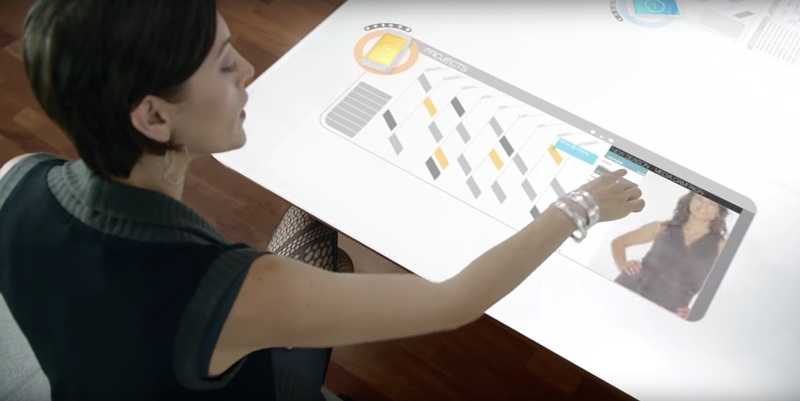
Those Unique Selling Points are, of course, that:
- W10M is full Windows 10, running core modules and applications that are universal across all form factors.
- With Continuum and other 'Connections', W10M can extend its interface to take over nearby displays.
I've often quoted Corning's Day Made of Glass videos as genuinely inspirational, and I'm going to bring them up again. Have a look at the original and view it in the context of what you know about Continuum now and what we know Continuum will be able to do by the end of 2016, i.e. using input from wirelessly connected touchscreens and taking over the glass of other computing devices (with permission).
I know the Corning concept video goes much further than is practical in the next couple of years, but there are distinct similarities. The core idea is the same - to have your own sessions and data (so, logged in and authenticated services, local documents and media) available for interaction and presentation on almost any screen you come across, as the need arises. Whether that's some kind of laptop dock that you brought with you, a hotel suite TV, a dumb monitor in an office booth, a living room TV, even a projected display on a wall or in mid-air through the likes of HoloLens.
The main objection to the current implementation and limitations of Continuum is: why bother? Why cart around extra cables and an extra Bluetooth mouse and/or keyboard, plus perhaps a physical dock, power supply and cables, when you can just take along a super-light 13" notebook PC or Mac? Why indeed? The objection is perfectly valid, but somewhat misses the future of the Continuum concept.
If your computing environment can be contained within just (say) a 5" screened smartphone and a 13" laptop, both loaded up with apps and signed in to all your services, servers and so on, then yes, this is a perfectly valid way to go. But what happens when you want to use something bigger, either because of the nature of the data or because you're projecting it for others to see? What happens when you want to use an entire table as your work surface, dragging things around and exploring options in the way demonstrated in the Corning video? Do you then have to have a phone, a laptop, a projector, loads of cables and adapters and so on, all individually customised and signed into the stuff you need to access? Or do you beg time on other peoples' laptops, desktops and conferencing systems, starting up new sessions and user accounts, working around what's available to get authenticated again and again?
Or you could just use Continuum.
One device, one biometrically authenticated pocket computer, think a Surface 960 XL (like a 950 XL but with four times the horsepower and 6GB of RAM), running Windows 10 'Redstone 2' in 2017. On it, you have all the applications you need, all signed in as you, with all your data, favourites, documents, contact context.

Following the rough pattern of the Corning video:
- you wake to your 960 XL chirping and glowing gently
- while you shower, you connect to a (safe) touchscreen monitor in the bathroom, casting news media or whatever you want to see that time in the morning(!), perfoming some simple search queries using the on-screen virtual keyboard on the monitor.
- grabbing some breakfast, you switch the connection to your kitchen TV and bring up your email, browsing through with multitouch and tapping out the odd reply using a spill-proof, wipe-clean Bluetooth keyboard that you keep on the kitchen counter.
- in the car, your 960 XL intelligently hooks up to your audio and visual systems, keeping you safe and communicating while on the road
- at work, you plug in your phone (via a USB Type C cable, to power and Ethernet) and your 26" QHD monitor springs to life, showing your preferred desktop and applications, with notifications that you'd seen arrive on the phone while driving but which you can do something about now that you're on the big screen.
- called to a colleague's office to discuss something, you 'borrow' his big touchscreen 'Surface' to demonstrate some ideas you've been working on.
- heading off on a business trip that evening, you decide to bring along your Continuum lap-dock. Again, it's every app and service on your phone, but this time on a 15" screen and with a full size keyboard and trackpad. With a 15 hour battery life, it's going to see you through the trip with power to spare.

And that's all in addition to the hundreds of small things you might accomplish each day on the smartphone's own touchscreen.
What's interesting is that almost all of this is do-able right now, on the Lumia 950 XL, provided all the various 'glass' is compatible. And that's partly what (for example) the push to get Windows 10 for desktops Continuum ready is about - it's all part of a grand vision for how computing might work, starting now but really getting going in the next couple of years.
Today's Continuum is sometimes easy but, let's face it, often a bit fiddly and half-hearted. But tomorrow's Continuum should be much easier, smoother, faster and more capable, thanks to better software, faster processors all round and more wirelessly compatible monitors and other display devices.
And, as Jason Ward points out in the linked articles above, although the competition (Google and Apple) both have interesting ideas in terms of hooking up different interfaces and devices, none of these comes close to what Microsoft is attempting with 'Windows 10 everywhere'.
So the next time someone tells you that "Windows Phone is dead", reply along the lines of "Dead? Windows on phones might just be the next big thing!"
